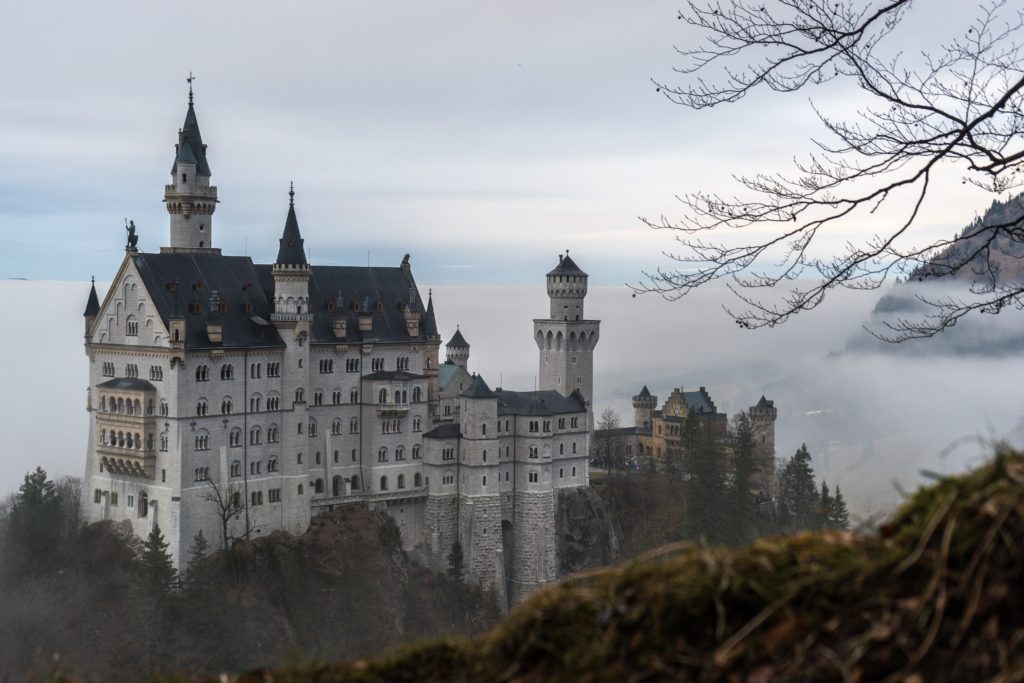
Rachel Davis/ via Unsplash
Did you know Neuschwanstein Castle, the most photographed building in Germany, was also the inspiration for this iconic castle?

Jorge Martinez/ via Unsplash
Do you think Walt Disney knew that the King who built the original Cinderella’s Castle was clinically insane?
Before we get into that, let’s talk about Neuschwanstein Castle’s history. Ludwig once wrote, King Ludwig II of Bavaria commissioned the castle in 1868, and it remained unfinished until his death 18 years later in 1886. It was built on the location of two smaller castles, Vorder and Hinterhohenschwangau, and was meant to be called “New Hohenschwangau Castle” (and you thought Neuschwanstein was hard to pronounce). Ludwig had built the castle shortly after losing a war with Prussia, which resulted largely in his loss of power. Nicknamed the “fairy-tale king”, among other names, many believed he used the construction of Neuschwanstein to escape his reality and create a Kingdom where he could truly rule.
“The location is one of the most beautiful to be found, holy and unapproachable, a worthy temple for the divine friend who has brought salvation and true blessing to the world.”
While all that may be true, the location also provided many challenges in the construction, making this a very expensive home for Ludwig. Castles don’t come cheap, and the building of Neuschwanstein, along with several other palaces, eventually bankrupted Ludwig, and therefore Bavaria, leading to his next nickname–The Mad King.
As Ludwig focused more and more on building his fairytale kingdom, along with being a notable patron of the arts, he increasingly withdrew from his public life and duties. His neglect of his sovereign duties angered and embarrassed both family and opposition, making him seem unfit to rule. He soon began to exhibit strange behaviors, including threatening to take his own life if he could not continue construction. Ironically, these threats would prove to be deadly for the King.
Seen as an insane recluse by the reigning powers, Ludwig II was forcibly removed from the throne on June 10th, 1886. Diagnosed with the 21st century equivalent of Schizophrenia, his rumored insanity was confirmed by Bernhard Von Gudden, a psychiatrist whose tactics were radical even for the time. Gudden often treated mentally ill patients with “moral treatment”, which primarily included physical pain. However, the Mad King didn’t suffer for long, as he and Gudden were found dead merely 3 days after Ludwig was detained in Berg Palace.
Ludwig II and Gudden went for an evening walk on June 13, 1886. The pair were due back at 8pm, but never returned and were later found floating in the nearby Lake Starnberg. It was assumed that Ludwig took his own life by drowning, but Gudden’s death went largely unexplained. Weirder still, the autopsy showed that no water was in Ludwig’s lungs after his death. Was he crazy, or was he killed?
King Ludwig II was succeeded by his brother Otto, who was also previously diagnosed by Gudden as insane, and therefore also unfit to rule. Their uncle, Luitpold, remained Prince Regent, gaining what little power Ludwig II once had. The shift in power also created a shift in blame amongst those that suspected murder, as both family and enemy alike have been tied to their deaths.
Several conspiracy theories have come out over the years, including reports that fisherman heard shots fired at the time of the deaths, that a post-mortem portrait of Ludwig shows blood coming from his mouth, that the doctor who performed the autopsy admitted to writing a false report, and that the pair were shot rather than drowned. One of the most convincing theories comes from Detlev Utermöhl, who claims to have seen proof that the Mad King was murdered. While visiting Countess Josephine von Wrba-Kaunitza, a relative of the late king, Detlev was allegedly shown a jacket riddled with bullet holes that was reportedly worn by Ludwig when he died. Having gone public with his so-called memories, many have called for Ludwig II’s body to be exhumed and reexamined, but the family has consistently refused, letting the mystery live on.
While the palace was never meant to be open to the public, over 50 million tourists have participated in Neuschwanstein Castle tours since Ludwig’s death. Come for the beauty, stay for the conspiracies. Was is the Uncle? The Brother? The Butler? Take a Neuschwanstein Castle tour and decide for yourself.
Related articles

